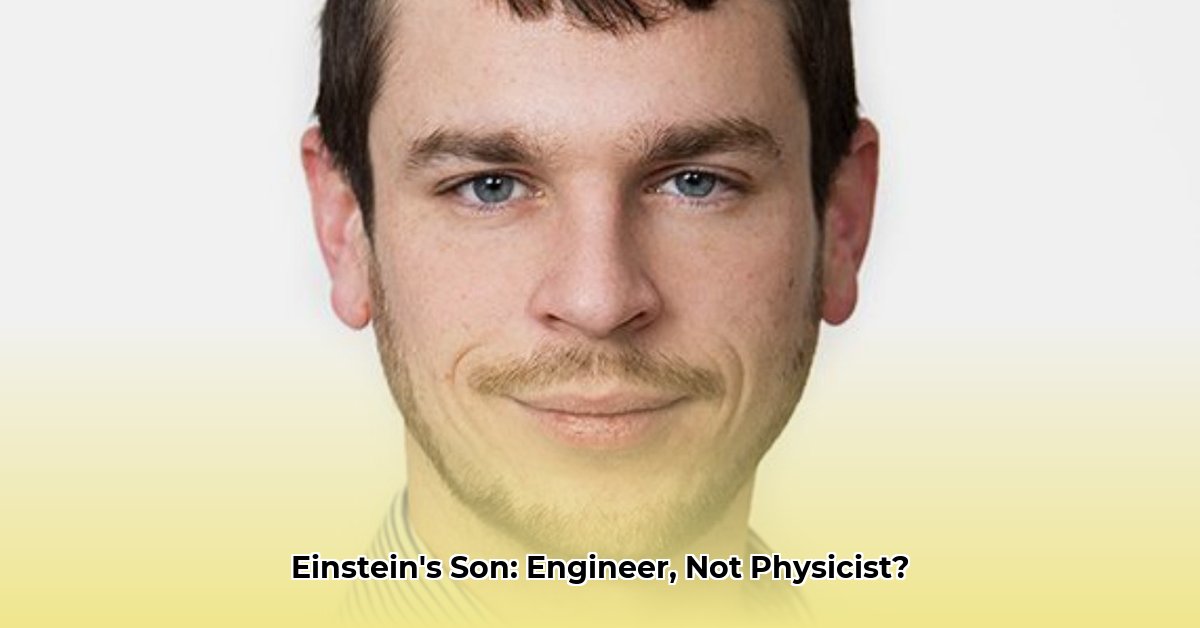Bernhard Caesar Einstein, grandson of the iconic Albert Einstein, charted his own distinguished course in engineering. This article explores his career, innovations, and patents in electronics and laser technology, revealing his impact on fields like night vision. For more details on his engineering career, see this informative page.
A Path Forged in Engineering: Bernhard Caesar Einstein’s Career
Bernhard Caesar Einstein, while carrying a renowned name, established himself as a notable engineer, particularly in electronics and laser technology. His accomplishments speak volumes about his inherent talent and unwavering dedication. Let’s delve into the details of his professional journey.
Building Blocks: Early Life and Education
Details surrounding Bernhard’s early life are not widely known. However, it is evident that he possessed a strong educational foundation. While specific information is scarce, one can assume rigorous training in electronics and engineering laid the foundation for his future success. Further research into his academic background would provide valuable insights into the institutions he attended and the influences that shaped his career path.
At the Forefront of Innovation: A Career in Electronics and Laser Technology
Bernhard’s professional life flourished in the realms of electronics and laser technology. He held significant positions at leading companies like Texas Instruments and Litton Industries. These roles placed him at the cutting edge of technological progress and allowed him to actively contribute to the ever-evolving tech landscape.
Patents: A Testament to Ingenuity
Bernhard’s patents serve as tangible evidence of his innovative thinking and inventive contributions. His work, particularly in light amplification devices, proved crucial for technologies like night vision. Although further research is needed to determine the exact number and specifications of his patents, they underscore his significant impact across diverse fields.
A Calculated Move: Choosing Engineering
Bernhard’s decision to delve into engineering rather than follow in the footsteps of his grandfather by pursuing theoretical physics highlights a deliberate shift toward practical innovation. This strategic choice underscores his desire to make tangible contributions and develop real-world solutions.
Illuminating the World: Unseen Contributions
Bernhard’s engineering advancements had a significant impact on the development of night vision technology. His contributions to light amplification devices enhanced safety, security, and operational capabilities for various sectors.
Further Exploration: Unveiling the Complete Picture
Many facets of Bernhard’s life, including personal details, collaborations, and influences, warrant further investigation. Ongoing research promises to paint a more comprehensive picture of his motivations and the broader context surrounding his work.
A Lasting Imprint: The Legacy of Practical Innovation
Bernhard Caesar Einstein’s career exemplifies the profound impact of individual achievements. His contributions to electronics and laser technology continue to shape modern technological advancements, reminding us that innovation takes many forms and can emerge from unexpected paths.
Bernhard Einstein and the Evolution of Night Vision Technology
Bernhard Caesar Einstein, the son of Hans Albert Einstein, was instrumental in the field of engineering. His contributions to electron tubes and laser technology brought about major improvements in night vision capabilities. This section delves into the specifics of his work and its influence on night vision.
Diving into Electronics
Bernhard’s work at Texas Instruments and Litton Industries honed his specialization in electron tubes and laser technology, essential components of night vision systems. His patents likely contributed to the enhanced efficiency and miniaturization of these key components.
Advancements From Tubes to Lasers
Bernhard focused on refining electron tubes, making them smaller and more efficient. His laser technology expertise undoubtedly played a crucial role in laser-based light amplification. These advancements resulted in more practical and wieldy night vision devices.
The Documentation Challenge
Pinpointing the precise impact of Bernhard’s patents on specific night vision devices remains a challenge. Limited public documentation makes it difficult to trace his influence directly. Further archival research is essential to fully understand the extent of his contributions.
A Quiet Innovator’s Enduring Influence
Bernhard Caesar Einstein’s contributions to night vision largely involved improving existing technologies. His patents facilitated advancements in the miniaturization and efficiency of critical components, ultimately contributing to the enhanced capabilities of night vision devices.
Key Takeaways:
- Bernhard Caesar Einstein greatly impacted the fields of electronics and laser technology.
- His expertise was directly relevant to the advancement of night vision devices.
- Although specific patent details require further exploration, his overall impact is undeniable.
- Access to company archives is crucial for a more complete understanding of his achievements.
- Bernhard’s story underscores the importance of contributions beyond those that are widely celebrated.
The Role of Bernhard Einstein’s Patents in Night Vision Technology
Key Takeaways:
- Bernhard Caesar Einstein made a name for himself in engineering, distinct from his family’s physics legacy.
- He made significant contributions to companies such as Texas Instruments and Litton Industries. This underlines his expertise in electronics and laser technology.
- His US patents drove innovation in vacuum tubes and microchannel plate stabilization, critical in night vision applications.
- His work directly influenced light amplification technologies, essential for modern night vision systems.
- His innovations had potential implications for military technologies.
Vacuum Tubes and Microchannel Plates: A Foundation of Innovation
Bernhard Caesar Einstein’s focus on electronics and laser technology is evident through his work with industry leaders like Texas Instruments and Litton Industries. His patents centered on improving electron tubes and microchannel plates, which are significant components in early night vision systems.
Deciphering the Impact
The connection between Bernhard’s patents and night vision technology indicates his expertise in light amplification. This technology would have been invaluable, particularly in his work for the Swiss Army Research Lab.
His patents on microchannel plate stabilization are significant because these plates are critical in light amplification systems used in night vision equipment.
Uncovering Hidden Contributions
Scholars should explore company archives, patent files, and military records to uncover the full story of Bernhard Einstein’s contributions. A comprehensive biography that details his accomplishments is long overdue. Technology companies should explore the potential applications of his patents, which may hold unrealized opportunities.
Unveiling Electronics Innovations by Bernhard Einstein: A Closer Look at His Patents
Key Takeaways:
- Bernhard Caesar Einstein pursued a successful career in electronics, independent of his family’s widespread fame.
- He was granted US patents in fields related to light amplification.
- His professional background included education at UC Berkeley and ETH Zurich, as well as work at Texas Instruments and Litton Industries.
- While more research is needed, his contributions to fundamental technologies are evident.
- His journey illustrates independent success and personal strength.
- Further research could reveal modern applications of his patents.
A Career Path in Electronics
Bernhard Caesar Einstein’s career revolved around light amplification in electronics. His education at UC Berkeley and ETH Zurich, paired with practical experience at Texas Instruments and Litton Industries, equipped him to secure several patents in this field.
Diving Deeper into Specific Patents
Although specific details regarding Bernhard’s patents and their commercial applications are scarce, his work at Texas Instruments and Litton Industries points to inventive contributions. Archival inquiries are required to uncover the specifics of his innovations.
Unearthing the Details
Analyzing his patent applications is essential for understanding his inventions. Knowing how each patent functioned as a component helps to illuminate its function within a larger technological framework. Understanding the technological context of his era is also crucial.
A Legacy of Innovation
Bernhard’s achievements—patents, work for industry leaders, and contributions to the electronics field—highlight his standalone success. Gaining a more complete understanding of his work could further emphasize this point. His contributions to night vision technology are especially noteworthy. Future research is paramount in fully recognizing his legacy.
Charting the Course Forward
Future research must comprise not only archival investigations but also thorough analyses of his patent applications. These documents are expected to reveal the precise technical complexities of his inventions. Comparing them to contemporary technologies would help establish their relative significance. Companies may find inspiration in his designs, and his story serves as a reminder of the historical potential that lies within earlier innovations.










